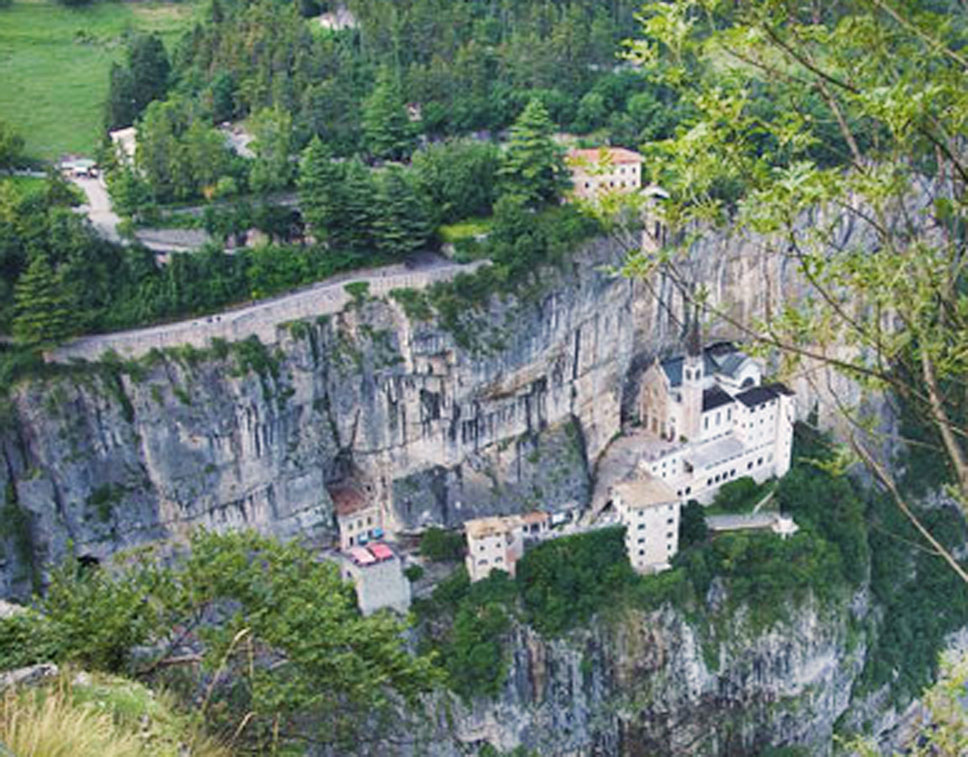In the Province of Verona sits perhaps Italy’s most unlikely church. The Santuario Madonna della Corona, or Sanctuary of the Lady of the Crown, looks as though it is nearly suspended in mid-air. Located only two miles from the eastern shores of Lake Garda, the shrine was built over 2,500 feet above sea level into a vertical cliff face on Italy’s Mount Baldo. The church does not actually hang on the sheer face, but sits on a thin rock shelf. Originally, it could only be reached by a narrow path from below, but fortunately there is now a road that leads to the church providing the most common access for visitors.
Many centuries ago, the secluded shelf was home to a hermitage. Medieval documents show that hermits from the Abbey of Saint Zeno in Verona lived in the Baldo area beginning around the year 1000. By the mid-13th century, there was a monastery and a chapel dedicated to St. Mary of Montebaldo. Here, the devout would come for silent reflection, completely removed from the rest of the world, since the chapel could only be reached by ascending a treacherous mountain path.
Holy tradition dates the birth of the Shrine of Our Lady of the Corona to 1522. In that year, a statue of the Pietà appeared at the chapel. It was said to have been miraculously transported by angels from the Island of Rhodes, when it was invaded by the Muslim army of Suleiman I. The venerated statue was actually a gift from Lodovico Castelbarco, a nobleman from Rovereto, but the statue did come from Rhodes. Pilgrimages began for the faithful to pray before the 27-inch tall statue. As more pilgrims visited, a decision was made to build a new chapel atop the original. Completed in 1530, it measured 60 feet long by 23 feet wide, snuggly fitting on the rock ledge. Some intrepid visitors still make the arduous climb.
The 16th century saw the creation of two sets of access steps that can still be seen. Even with the stairs, it was not an easy journey to the chapel. The first steps constructed are narrow, cut from the rock along the original path to the shrine. A wider stairway, completed later, was easier to traverse, but the Sentiero del Pellegrino is not an easy ascent. The path is about 1.5 miles, rising the entire way, carving a steep route through the mountains. Depending on rest stops, it takes roughly two hours.
In 1625, work began on the construction of a new church situated above the previous chapel. The work went on for decades and was finally finished in 1685. The work included Scala Santa, a replica of the stairs to Pilate’s palace that Jesus ascended before he was condemned to be crucified. These lead from the ground level to the church. The shrine was enlarged and given a Gothic-style façade and marble embellishments at the end of the 19th century. Carrara marble statutes by sculptor Ugo Zannoni were added in the next decade, followed by the rebuilding of the bell tower and the addition of a church steeple in 1922. It was during that decade that the road above the church was constructed.
In 1974, architect Guido Tisato oversaw extensive work replacing portions of the church, preserving its most important and significant parts. Reconstruction was completed in 1978. In 1982, the shrine was visited by Pope John Paul II and for the past 40 years has had the title Santuario Basilica Madonna della Corona. Most visitors arrive at the shrine from the tiny village of Spiazzi. You can take a shuttle bus or walk along a paved path down to Santuario Madonna della Corona. The walk takes about 15 minutes, admiring the bronze Stations of the Cross along the way.





